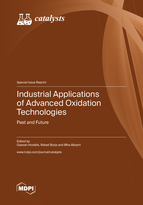Industrial Applications of Advanced Oxidation Technologies: Past and Future
A special issue of Catalysts (ISSN 2073-4344). This special issue belongs to the section "Photocatalysis".
Deadline for manuscript submissions: closed (18 May 2023) | Viewed by 36468
Special Issue Editors
Interests: advanced oxidation processes; kinetic growth; biomass growth, industrial and urban wastewater, contaminant removal; wastewater treatment; clean technologies; sustainability and regeneration of wastewater; circular economy
Special Issues, Collections and Topics in MDPI journals
Interests: anaerobic digestion; aerobic treatment; agricultural and food solid wastes; integral treatments (pre-treatments + anaerobic digestion); agro-industrial wastewaters
Special Issues, Collections and Topics in MDPI journals
Interests: environmental chemistry; water purification; olive oil mill wastewater; photocatalytic degradation; heavy metal remediation; adsorption; chemical extraction
Special Issues, Collections and Topics in MDPI journals
Special Issue Information
Dear Colleagues,
The modernization of our society and the great technological advances, whether in the agro-food, chemical, pharmaceutical, or biotechnological sectors, have allowed the establishment of large industries in the last fifty years. Most of these industries are characterized by the high consumption of drinking water that is transformed into wastewater as it leaves these industrial processes. Unfortunately, a large part of this wastewater is difficult to treat due to the presence of a high organic load, persistent compounds, toxic and inhibitory compounds, etc. This fact has generated a challenge to conventional urban wastewater treatment plants (CUWTPs) that are increasingly unable to meet the standards set by local, national, or international legislation, being the accomplishment of pre-treatments or treatments of adaptation before their discharge to the CUWTPs of obligatory compliment by the industries. On the other hand, in the last decade, climate change has been evident due to the high values of the carbon footprint and the hydraulic footprint registered by the industries. Not to mention, the availability of drinking water is scarce in many countries.
The use of photocatalysis for wastewater treatment is an important area of research, which is not yet fully exploited at an industrial level and has significant potential in the disposal of many industrial effluents. In particular, the effluents that are difficult to treat by conventional treatment processes. Given the positive response from researchers to our first Special Issue entitled "Photocatalysis in the Wastewater Treatment", this new special volume represents a second edition and aims to explain to society the importance of advanced oxidation technologies and how their incorporation into the industrial sector as green and clean technologies can improve the current situation of ecosystems and the global environment. In this sense, it is worth mentioning the treatments based on photolysis, TiO2/solar light, ozone/ultraviolet irradiation, oxidants/ultraviolet irradiation, oxidants/catalyst/ultraviolet irradiation, high-energy electron beam irradiation (E-beam), sonication/photocatalysis, etc. The Special Issue also includes combined processes that integrate photocatalysis techniques as pre-treatment or post-treatment stages.
Prof. Dr. Gassan Hodaifa
Dr. Rafael Borja
Dr. Mha Albqmi
Guest Editors
Manuscript Submission Information
Manuscripts should be submitted online at www.mdpi.com by registering and logging in to this website. Once you are registered, click here to go to the submission form. Manuscripts can be submitted until the deadline. All submissions that pass pre-check are peer-reviewed. Accepted papers will be published continuously in the journal (as soon as accepted) and will be listed together on the special issue website. Research articles, review articles as well as short communications are invited. For planned papers, a title and short abstract (about 100 words) can be sent to the Editorial Office for announcement on this website.
Submitted manuscripts should not have been published previously, nor be under consideration for publication elsewhere (except conference proceedings papers). All manuscripts are thoroughly refereed through a single-blind peer-review process. A guide for authors and other relevant information for submission of manuscripts is available on the Instructions for Authors page. Catalysts is an international peer-reviewed open access monthly journal published by MDPI.
Please visit the Instructions for Authors page before submitting a manuscript. The Article Processing Charge (APC) for publication in this open access journal is 2700 CHF (Swiss Francs). Submitted papers should be well formatted and use good English. Authors may use MDPI's English editing service prior to publication or during author revisions.
Keywords
- photocatalysis with solar energy
- photo-Fenton
- O3/UV
- TiO2/catalyzed/UV oxidation
- H2O2/UV
- high energy electron beam
- sonication/photo-Fenton
- photoreactor configuration
- pesticide removal
- wastewater treatment
- combined chemical and biological processes








